Content
Blackberry propagation can be carried out in several ways throughout the warm season. To choose the most convenient and effective method, you should explore all the options.
Breeding features at different times of the year
The best time for shrub breeding is early spring and autumn. Like any plant, during these periods the blackberry grows the root system faster, since it does not spend resources on the development of green mass. However, there are ways to increase the crop population on the site even during the height of summer.
How to propagate blackberries in spring
The spring period is optimal for planting blackberries with an already existing root system. You can propagate a culture:
- seedlings;
- stem and root cuttings with overgrown underground rods;
- root suckers;
- dividing the bush.
In all cases, you need to choose a dry and warm, but cloudy day for planting. The soil should thaw by the time of the procedure.
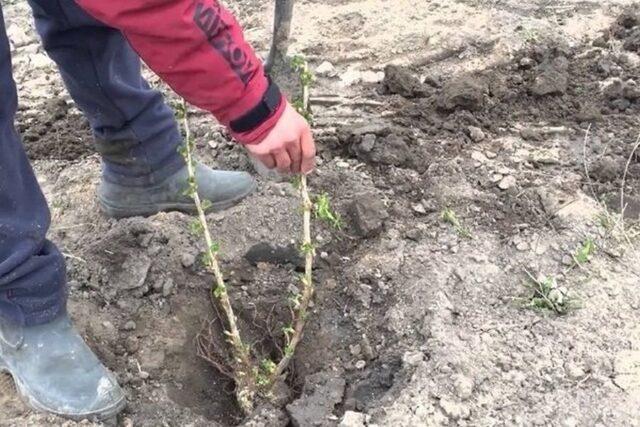
Reproduction should be carried out in the spring after temperatures of about 10 ° C are established.
How to propagate blackberries in summer
In the summer period, rooting of green and lignified cuttings, as well as horizontal and apical layers, is most often carried out. Until autumn, parts of the plant have enough time to build up the root system. Reproduction is usually carried out on a cloudy dry day, the weather is chosen as cool as possible.
The main danger of summer rooting is that cuttings and seedlings do not tolerate drought well and may not take root in the heat. For reproduction to be successful, it is necessary to regularly water the blackberries until autumn as the soil dries up. The soil around the seedlings and cuttings is mulched with a material that prevents rapid evaporation of moisture.
How to properly propagate blackberries in the fall
It is most convenient to propagate blackberries from a bush in the fall by dividing, planting sprouted cuttings and rooting horizontal and apical layers. If the procedures are carried out a few weeks before the cold weather, the culture will have time to safely take root in a new place and, with the onset of spring, will start to grow.
In addition, in the fall, it is customary to harvest lignified cuttings and root suckers. The culture tolerates the separation of shoots well before the onset of winter - the sections quickly overgrow and rarely begin to rot.
Breeding methods for garden blackberries
Blackberries on the site can be propagated by seeds and numerous vegetative methods. Each of the methods has its own advantages.
By dividing the bush
By division, erect blackberries are most often propagated, which do not give offspring and at the same time does not allow young shoots to bend to the ground. The method is optimal for well-developed shrubs over 4-5 years old, with a powerful root system and numerous stems.
The breeding procedure looks like this:
- A healthy and strong blackberry bush is dug out of the ground, being careful not to damage the roots. The plant should be watered well beforehand, in which case it will be easier to remove it from the old place.
- With a sharply sharpened and clean shovel or ax, the blackberry rhizome is divided into several parts. Each of them should have at least two strong aerial shoots and one underground bud.
- Delenki carefully examine and remove damaged, dry or rotten areas of the roots. All cut sites are treated with wood ash, crushed coal or potassium permanganate solution to avoid infection.
- The resulting seedlings are immediately transferred to the prepared holes. The indentations in the soil for the blackberries should be about twice the size of the roots of the seedlings.
After planting, the delenki are watered abundantly, mulched in a circle and over the next weeks monitor the condition of the soil, not allowing it to dry out.
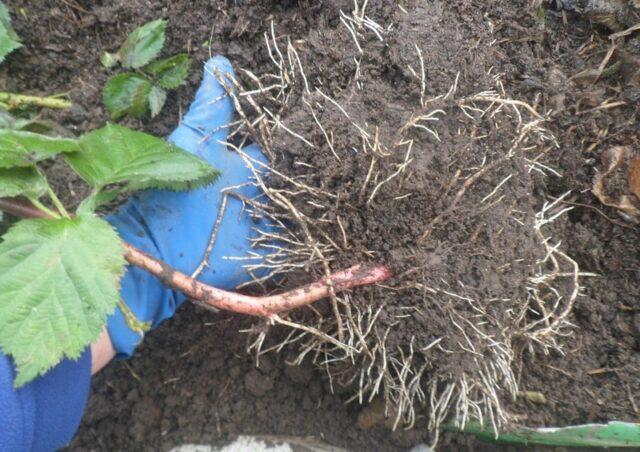
Reproduction by dividing the bush is recommended to be carried out a month before the first frost
Apical layers
The apical layers are usually used for propagation of varietal blackberries of creeping varieties; in such plants, the shoots can be easily bent to the ground. The procedure is best carried out in August and September, so that before the cold weather the culture has time to give new roots.
The selected blackberry shoot must be cleaned of leaves and pinched off the growth point on it. After that, the branch is tilted and buried in the ground up to 10 cm with the upper part. It is better to separate the apical layers from the mother plant with the onset of spring.
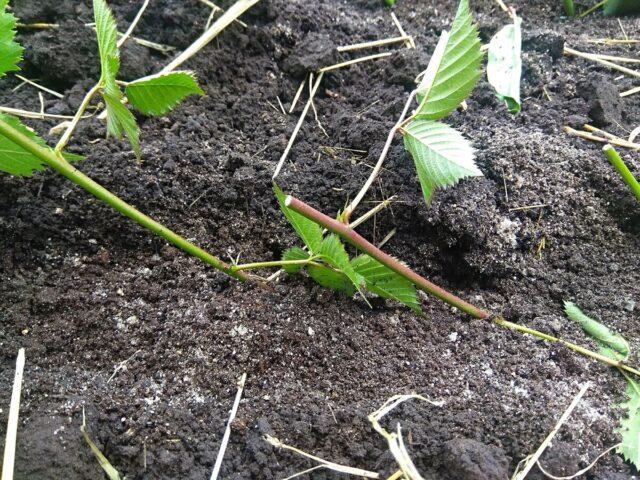
Until the end of the season, the apical layers need to be moistened weekly
Horizontal layering
Reproduction of garden blackberries by horizontal layers is also used mainly for creeping varieties. It is necessary to choose a young flexible shoot, tilt it to the ground and deepen it to 20 cm so that the base and top protrude from the soil.
With regular watering, after 1-2 months, the layering forms new roots in the recessed part. In autumn or spring, it can be separated from the main plant.
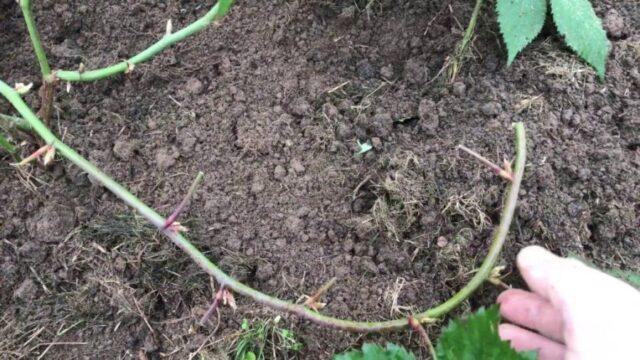
The top of the horizontal layer must be cut off, otherwise the shoot will not give new shoots
Root offspring
Many varieties of blackberries give offspring - shoots that grow at a short distance from the mother bush from root segments. Usually you have to fight with them in order to prevent thickening. But if necessary, the offspring can be used for their own purposes.
Reproduction of bush blackberries is carried out as follows:
- At the end of May or at the end of August, several strong, non-curved offspring with a shoot thickness of at least 8 mm are found on the plant.
- Carefully dig out the root system of the blackberry and select those stems in which the underground part has the longest shoots up to 20 cm and a powerful lobe.
- With a sharply sharpened tool, the offspring is separated from the mother bush and immediately transferred to a new place according to the same algorithm as an ordinary seedling.
With this method of reproduction, blackberries can bloom as early as the second year after planting. However, it is advisable to remove the buds so that the plant can focus on root development and produce a more bountiful harvest in the next season. It is convenient to propagate upright varieties with root suckers.
Root cuttings
Blackberry root cuttings differ from offspring in that they do not have a well-developed aerial part, they only have non-germinated buds. But such material is also well suited for reproduction:
- In October or November, the blackberry tree trunk circle is slightly dug up and parts of the roots are cut at least 10 cm in length with a diameter of up to 4 cm.
- For the winter, offspring in wet sand is removed to a dark, cool place, for example, in a cellar. It is necessary to save the planting material so that it does not start growing until the next season.
- With the onset of spring, the offspring are buried in the selected area to a depth of about 5 cm. They need to be placed horizontally.
- Planting material is regularly watered until new shoots appear.
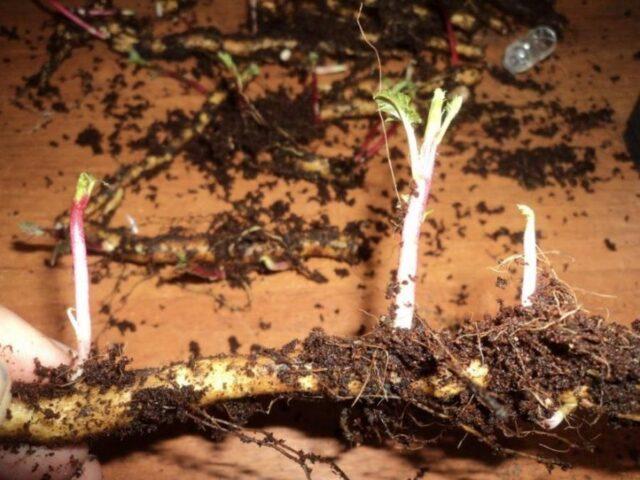
When planted in spring, root cuttings have time to give 2-3 well-developed shoots per season.
Lignified cuttings
Lignified cuttings are the most unreliable method of blackberry propagation. However, the method is used if the terms for preparing green shoots have already been missed, and there is no opportunity to use offspring and layering.
In the middle of autumn, sections of lignified branches are cut up to 30 cm long. Until spring, they are kept in the cold, and with the onset of heat, the cuts are updated and laid out in rows, sprinkling with earth on top. The cuttings must be watered and weeded from time to time; to speed up the process, you can stretch plastic wrap on top. After the formation of young shoots with leaves and roots, the planting material will need to be dug up and distributed in pots or transferred to temporary beds.
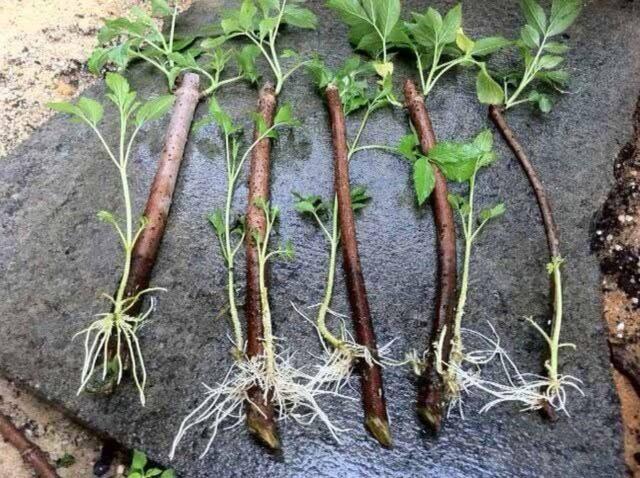
Shoots from lignified cuttings are planted in a permanent place when a pair of true leaves appears
Green cuttings
For propagation by green cuttings, young shoots of the current year are used. In June and July, flexible stems with several internodes are cut, the lower leaves are removed, and the upper ones are shortened by half. The cuttings are dipped in a growth stimulator, and then planted in a temporary bed or in pots and covered with a jar on top to create greenhouse conditions. After about 3-4 weeks, the rooted shoots are transferred to a permanent place.
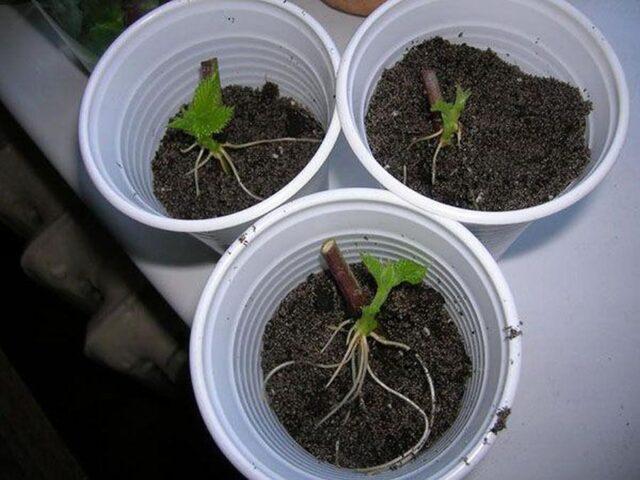
The upper two buds of green cuttings are pruned before propagation
Reproduction of blackberries by seeds at home
Vegetative methods can be used to rapidly increase the shrub population. But it is also realistic to propagate blackberries at home from seeds - with one-hand collection, the germination rate reaches 80%.
To obtain planting material, you need to take healthy, ripe berries, gently crush them and rinse in water. At the same time, good large seeds will settle to the bottom of the container, and they must be used for reproduction.
The germination algorithm is as follows:
- The washed seeds are dried on a towel, and then put into the refrigerator for three months in wet sand. Stratification improves the germination of the material and strengthens the endurance of the blackberry.
- In early March, the seeds are removed from the refrigerator and sown in shallow but wide containers in a nutritious substrate consisting of sand, peat and garden soil. It is necessary to immerse the grains up to 5 mm.
- Sprinkle the seeds abundantly with water on top and cover the container with a transparent film. For several weeks, the container is placed under a special phytolamp at room temperature, remembering to moisten the soil every five days.
- After the appearance of four true leaves, the seedlings are transferred to a temporary open bed, leaving a distance of about 15 cm between individual seedlings.
- During the summer, blackberries from seeds are regularly watered and complex fertilizers are applied, and the soil is weeded from weeds.
Before the onset of winter, the roots of the seedlings are covered with peat, sawdust or humus for insulation. The blackberries are transferred to a permanent place for the next year, when the plants are finally strong.

The upper two buds of green cuttings are pruned before propagation
Sleeping kidney
An unusual way of winter blackberry breeding suggests using dormant buds for germination. The diagram looks like this:
- In October, annual cuttings about 15 cm long with several buds are cut from the plant.
- Shoots are cleaned of leaves and stored for the winter in a cellar or refrigerator.
- At the end of February, the cuttings are removed and immersed upside down in a jar of water.
- The container is placed on a lighted windowsill and liquid is periodically added as it evaporates.
- After the bud has sprouted with roots, it is cut off and transferred to a pot of soil for growing.
In this way, you can wake up all the buds on the prepared cuttings. But it is important to immerse them in water one by one.
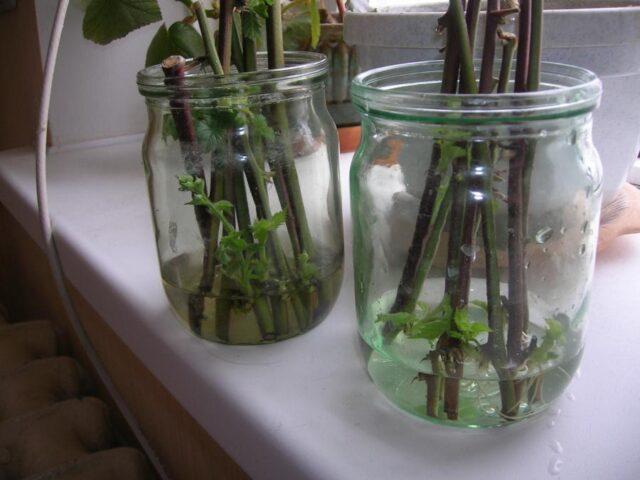
Dormant bud propagation is more effective than normal sprouting
How to propagate a studless blackberry
It is convenient to propagate thornless blackberries using vegetative methods. Namely:
- green cuttings;
- apical and horizontal layering;
- dividing the bush.
Garden blackberries without thorns rarely reproduce by offspring, since most varieties, in principle, do not have basal shoots. As for growing from seeds, when using it, the unique characteristics of the hybrids are often lost, in particular, the bushes can grow thorny.
How to propagate climbing blackberries
For climbing varieties of shrubs, propagation by horizontal and vertical layers is well suited. The shoots of such plants are thin and flexible, they can be easily tilted to the ground and fixed so that they do not straighten. Root cuttings and suckers, as well as seeds, can be used, but it is less convenient.
Conclusion
Reproduction of blackberries is a fairly simple task that can be accomplished in several ways. If there is at least one adult plant bush on the site, then you will not have to buy seedlings from nurseries to increase the crop population.
https://youtu.be/AQmPIFMEDmA








